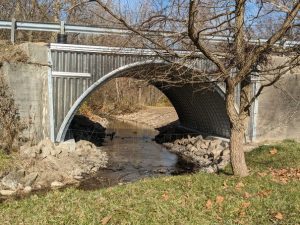What’s the Goal?
The report aims to develop closed-form equations to estimate seismic demand on typical geometries of bottomless corrugated metal buried bridges. The equations are intended to simplify the screening of seismic demands and be consistent with the existing AASHTO design methods for these types of structures.

Why This is Important?
The motivation for this research stems from the fact that current codes do not require seismic design of buried structures, such as culverts or buried bridges, based on their historical performance relative to above-ground structures. However, there are cases where seismic demand on buried structures should be considered in design, especially for structures with spans greater than 20 ft and those with life-safety implications.
What’s Missing?
The report highlights that previous research has developed simplified seismic analysis approaches for rigid box structures and simplified closed-form seismic demand equations for rigid and flexible circular pipes. However, there is no simplified design method available for typical geometries of buried large-span corrugated metal arches on footings.

What We Learned
To address this gap, the report details the development of closed-form equations based on the results of detailed parametric finite element analyses. The recommended equations estimate seismic demand due to lateral accelerations on typical arch-shaped corrugated metal buried structures. The equations consider parameters such as structure span, rise, fill depth, profile, thickness, structure material, native soil, and seismic lateral acceleration coefficient.
The report provides the specific equations for estimating the seismic design thrust and moment. The applicability of these equations is limited to typical structures and installations meeting certain conditions, as specified in a table provided in the report. Installations outside these conditions still require finite element analysis to determine seismic demands.
This new research report concludes that installations with larger structure span, deep cover, poor native soil, or high site seismicity are most likely to be controlled by seismic demand. It also notes that the design equations may be overly conservative for installations in very good native soils, but seismic demands are unlikely to control design in these cases based on AASHTO load combinations.

The report includes appendices that provide a summary of relevant literature and current practice, a design example demonstrating the use of the equations, and recommended changes to AASHTO to implement the equations.
Putting it into Practice
In summary, the report presents closed-form equations for estimating seismic demand on typical arch-shaped corrugated metal buried structures. These equations provide a simplified screening method and are intended to be consistent with existing AASHTO design methods. The equations are applicable to typical structures and installations meeting specific conditions. Installations outside these conditions require finite element analysis. The report recommends further research to extend the findings and improve the understanding of seismic behavior in buried structures.
Related Reports
Results of Testing of Polymer Precoated Steel Sheet According to ASTM A742
The Measured Performance of Aluminized Type 2 Steel Pipe in Storm Sewer Applications in the North Georgia Region
New Approaches to CSP Service Life